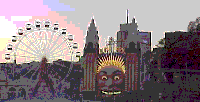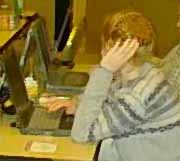Urban and perpetually underfunded through the final decades of the last century, the Middle School of the Future (previously named the Booker T. Washington Middle School) has dramatically closed the "digital divide" facing many urban schools today thanks to generous sponsorships, contributions and partnerships from technologically committed corporate friends.
For this school plagued by poor performance, illiteracy and low attendance during the 1990s, the principal of MSF has banked heavily on the possibilities of notebook computers and networked information. She is hoping to reverse the old patterns, equipping students with all the skills and competencies they might need to break into successful futures.
Sharon Jackson is a veteran principal with 30 years of doing the impossible. Every school she has touched has changed for the better. She has led with passionate beliefs. She has made students feel prized. She has created hope, and progress whenever she has led a school.
Never quite satisfied with her most recent efforts, Sharon has kept her eyes open for new resources, strategies and tools to lift student performance to higher levels.
Not so long ago, when Sharon attended a national conference devoted to the promise of networks and notebook computers, she found herself swayed by the testimonials of other educators . . .
She watched a series of PowerPoint™ presentations with slides promising major changes:
She liked much of what she heard and read, but she was also troubled by some examples of student work held up as evidence of great success.
The three-day conference was structured around dozens of PowerPoint™ presentations. Some of these slide shows came from fellow educators outlining the ingredients of a successful program. Others were student-produced.
As Sharon sat through the presentations, she was struck by the thin quality of the student work, with an emphasis upon flash and special effects rather than content and thought.
She had sat through too many flying letters, animations and sound effects without seeing much original thought or analysis. In most cases, the medium had shoved the message aside. Intent on producing students with strong reading, writing and thinking skills, she shook her head at the razzle-dazzle being promoted.
As she sat watching these presentations, Sharon remembered reading Jane Healy’s critique of these school technology uses in Failure to Connect (1998).
Even as she determined to pursue her dream of a school rich with digital resources, she realized that the path might be lined with temptations, distractions and elements of risk that the conference had failed to address.
Sharon had no intention of introducing her school to a new kind of illiteracy — an electronic version. Her prime goal was showing students how to make sense of their worlds, preparing them to think and read deeply and well. Her purpose was literacy — not illiteracy or e-literacy.
She had little interest in the flashy, the glib or the superficial. She was no fan of edutainment or technotainment. She was clear about her purpose.
Even as she moved forward with plans for a school well equipped with notebook computers, Sharon kept her focus on teaching, learning and thinking. To her, the equipment was nothing much more than a set of new tools to support questioning, exploring and creating. She fully expected that her students would make great gains on the tests recently introduced and causing panic across her state.
While schools consider the vast array of new electronic tools and resources made available by eager vendors and publishers, some teachers and school leaders are awakening to the challenge of resisting the glib, the superficial and the disneyfied aspects of the digital economy and society. In some cases, it seems as if installation and purchase precede purpose, but in others, a strong sense of educational philosophy helps schools sail past the shallow waters and the navigational hazards of this brave new electronic world.
This column, my final contribution to eSchool News, identifies the risks of edutainment and technotainment while suggesting strategies optimize return on technology investments as measured by gains in student performance.
Shallow Waters
Schools can ill afford technotainment activities during a time of tough new standards and tests. We might define technotainment as technology activities heavily laced with entertainment but essentially lacking in rigor or value. Technotainment often stresses technology for technology’s sake without enhancing student reading, writing and reasoning skills.
"What did you do in school today?"
"The Internet."
Such answers might mean anything from surfing pop culture sites to serious reading of periodical articles, but it often seems enough that students are using networked computers in some way — any way! Technology becomes a goal in itself.
To determine whether an activity falls under the category of technotainment, apply the following chart to the lesson:
To lift the performance of students on such challenging items, teachers must provide each student with a skill repertoire such as the one outlined in "Scoring High with New Technologies" at http://fno.org/apr99/covapr.html (From Now On, April, 1999).
- Questioning
- Picturing
- Awakening prior knowledge
- Synthesis
- Inferring
- Fluency
Gaining full competency with these skills then will require frequent and repeated practice on challenges similar to the items students will encounter on state tests as outlined in "Teaching to the Standards" at http://fno.org/nov99/standards.html (From Now On, November, 1999).
We are learning that it is not enough to wire schools or place networked computers in classrooms. We must make wise choices that focus on student outcomes worth achieving, upon value added rather than glitz, glimmer and gimmicks. We are moving past edutainment and technotainment to a new form of literacy combining the best of the old with the best of the new.
References
- TED — An organization committed to the value of TechnoTainment
- http://www.ted.com/ted.html
- McClintock, Robbie. The Educators Manifesto: Renewing the Progressive Bond with Posterity through the Social Construction of Digital Learning Communities. Institute for Learning Technologies -Teachers College, Columbia University (1999).
- http://www.ilt.columbia.edu/Publications/manifesto/
McKenzie, Jamie. Beyond Technology: Questioning, Research and the InformationLiterate School. FNO Press (2000). http://fnopress.com
-
 From Now On
From Now On
